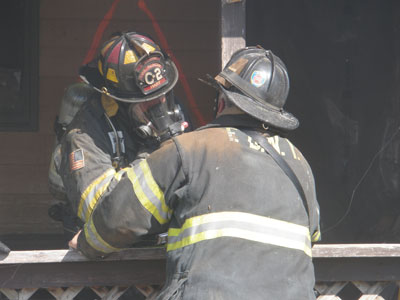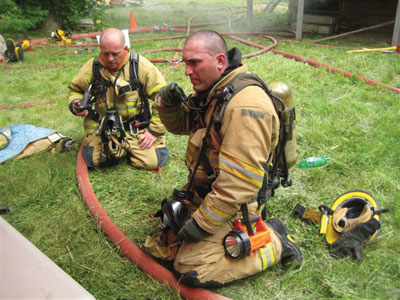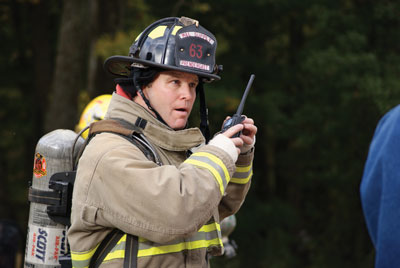
Features
Communication
Training
Back to Basics: September 2012
Communication plays a vital role in how well a fire department responds, reacts and conducts itself in its daily operation.
September 6, 2012
By Mark van der Feyst
Communication plays a vital role in how well a fire department responds, reacts and conducts itself in its daily operation. A communication breakdown can lead to a dysfunctional fire department or fire ground. Different types of communications are used in the fire service and all firefighters should be familiar with all of them: written communication, face-to-face communication, electronic communication and radio communication.
In the station, firefighters are exposed to written, face-to-face and electronic communication. Written communication includes memos, communiqués, e-mails, bulletins and so on. These are usually posted somewhere for all to see or they may be directed to one person. Either way, there is time for the recipients to read the item and gain an understanding of it. There is also time to ask questions for clarification and to engage in a discussion about the content of the written material. Electronic communication is in the form of e-mail sent via mobile phone, text message, Facebook posting or a tweet on Twitter. The message is generally short and sweet with little room for interpretation or discussion. The idea of electronic communication is to have quick dialogue with a person or group.
 |
|
| Face-to-face communication is the best, since it allows for instant acknowledgment between communicators. Photos by Mark van der Feyst. |
|
 |
|
| Knowing how to use a portable radio correctly is key to effective fire-ground communication. |
|
 |
|
| The receiver of a radio communication may not fully understand the message if distortion is an issue. |
On the fire ground, crews are limited to radio, electronic and face-to-face communication. Portable radio communication is the most common type of communication for most firefighters. A portable radio allows a team of firefighters to remain in contact with the incident commander (IC) and with each other. It is a lifeline for firefighters working on the fire ground. Without it, they are left to more primitive ways to communicate, such as face-to-face. The portable radio gives distance to the working crew by allowing firefighters to be farther away from the IC and still be able to report back or receive messages. Knowing how to use the portable radio correctly is the key to effective fire-ground communication.
Of all the ways to communicate with a person or group, talking face to face is the best. It allows the recipient and the sender to have instant acknowledgement from each other when passing on information, asking a question or giving orders. Facial expressions and body language are part of face-to-face communication and are often used to convey messages or the receipt of a message.
With radio communication, there is an opportunity to clarify the message to ensure that a full understanding is obtained. The downside to face-to-face communication is that it reduces the distance that a crew can work from the IC or sector officer. Proximity must be maintained in order to remain in contact with each other. The same goes for interior crews working with a limited number of portable radios and/or failure of portable radios. Defaulting back to traditional face-to-face or verbal communication will be the only way to communicate with each other.
For some firefighters, this is a lost art as dependence upon the portable radio is all they know. Training on how to communicate on the fire ground when the portable radio fails or is lost during an interior operation is a good idea. This will reinforce the traditional skills needed when the time comes – and it will come – as portable radios are electronic devices powered by batteries and they do fail.
When firefighters use portable radios on the fire ground, communication can become confusing and/or very hard to follow. One reason for this confusion is the use of 10 codes. The 10 codes were removed when the national incident management system (NIMS) came into existence.
NIMS was created and implemented as a result of the tragedy on Sept. 11, 2001. The communication breakdown that day and in the days following the terrorist attack on the United States led to the adoption of a common language called plain-text language. Plain-text language is everyday language that allows any person to be able to communicate with another. If different fire departments are working together at a fire, they can speak to each other using plain-text language. Within NIMS, there are provisions for common terminology that we need to use on the fire ground. Certain terms such as sectors, divisions, geographical designations of buildings (alpha, bravo, charlie and delta), roger acknowledge and over are to be used in an effort to reduce confusion over the airwaves when trying to communicate via a portable radio or by other means.
Another reason for communication confusion on the fire ground is firefighters yelling into the radio when trying to speak. When a sender yells into the radio, the message being transmitted becomes distorted, leaving the recipient wondering what was said. This can be due to improper positioning of the radio to the mouth when transmitting. Avoid holding the radio/mic directly in front of your mouth when speaking. Instead, hold the radio/mic on a 45-degree angle about two inches away from your mouth and you will send a clearer message. If you are wearing an SCBA facepiece, make sure the radio/mic is positioned at the communication portal on the facepiece; this enables you to speak clearly and not sound muffled. Holding your breath while relaying the message may also help; inhale a breath of air, then speak a few words, inhale again and speak a few more. The removal of breathing sounds helps to amplify the transmission.
Another method is to hold the radio/mic directly to the lens of the facepeice when speaking. This requires putting the radio almost at eye level on the outside of the lens. With the radio/mic in direct contact with the lens, sending a message comes across a lot clearer for the receiver. Avoid feedback among other radios on the fire ground when transmitting as it distorts the message. This can happen when all crew members have a portable radio and one person is trying to transmit. Turn away from other radios when you are transmitting a message.
Using these simple but basic steps in communicating on the fire ground will enhance the quality of the transmissions and remove the confusion factor for all.
Mark van der Feyst is a 13-year veteran of the fire service. He currently works for the City of Woodstock Fire Department. Mark is an international instructor teaching in Canada, the United States and India. He is a local level suppression instructor for the Pennsylvania State Fire Academy and an instructor for the Justice Institute of B.C. He can be contacted at Mark@FireStarTraining.com
Print this page